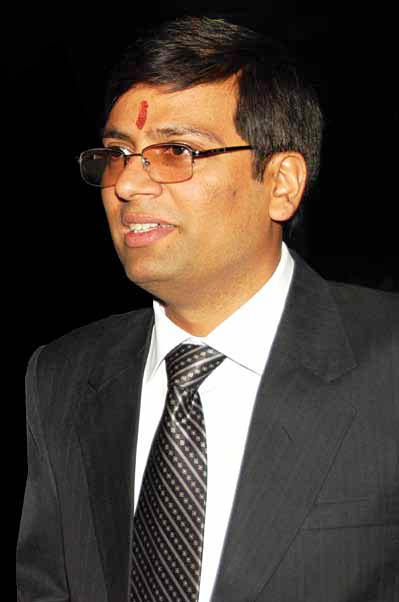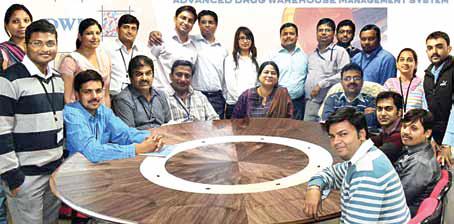

“When it comes to basic healthcare we have removed the distinction between BPL and non-BPL patients,” says Rajasthan Medical Services Corporation Managing Director Dr Samit Sharma
Give us an overview of the work that is being done by Rajasthan Medical Services Corporation in the State of Rajasthan.
The Rajasthan Medical Services Corporation (RMSC) has been created to implement the Chief Minister’s scheme of providing free medicines to all patients under “Mukhya Mantri Nishulk Dawa Yojana”. The scheme was launched by the Government of Rajasthan on October 2, 2011 and it has been implemented in all 33 districts of the state. e-Aushadhi was implemented to provide a complete supply chain management solution for the drugs under the scheme. It provides drug management service to various district drug warehouses (DDWs) of Rajasthan, medical colleges, hospitals, community health centres (CHCs), primary health centres (PHCs), and drug distribution centres (DDCs) from where drugs are issued to patients, the final consumers in the chain.

What is the main idea behind the creation of Rajasthan Medical Services Corporation?
RMSC has been created by the Government of Rajasthan with the idea of making healthcare affordable, especially for the poor. Currently drug prices are very high and healthcare is not affordable. About 40 percent of the admitted patients have to either borrow money or sell their assets to undergo treatment. Twenty three percent of the sick never go to a doctor or hospital because they are not having money to spend on healthcare. This is a grave situation, one that leads to thousands of deaths every day. This is a real tragedy. However, this is a preventable tragedy. The situation can be improved through an organisation like RMSC, which provides most commonly used essential drugs free-of-cost to all patients who visit government hospitals.
In your opinion, what are the major achievements of the scheme?
After starting this scheme, the number of patients has increased tremendously. Currently we are able to provide drugs to 2,30,000 patients a day, which is a huge number. Out of this, 80,000 patients have been added after starting this scheme. These are not just patients from Rajasthan. Patients are also coming from bordering states of Madhya Pradesh, Haryana and Gujarat who don’t have access to some specific drugs in their respective states. The central ides of the scheme is that no patient in need should be deprived of essential drugs.

How did you expand the scope of the scheme over the years?
Initially we started with 200 drugs, which subsequently increased to 400. Now the Chief Minister has announced that the number shall further be increased to 500-600. We have already started working on that.
 Quality healthcare is not only about availability of drugs, but also about doctors. What can be done to ensure that people in all parts of the state have access to good doctors?
Quality healthcare is not only about availability of drugs, but also about doctors. What can be done to ensure that people in all parts of the state have access to good doctors?
In my opinion there are four components of healthcare – infrastructure, healthcare manpower, drugs and investigations. In Rajasthan, the infrastructure is well developed and in most places good infrastructure is already in place. As for the health manpower, at PHC and CHC levels, the infrastructure is currently under-utilised, as number of patients is not adequate despite the fact that these places have qualified doctors and wellequipped staff. For instance, in a PHC the average number of staff was 10 and the average number of patients visiting the PHC per day was also 10. It is the district hospitals and medical college hospitals that have always been over-burdened. So the state government has started a new drive to recruit doctors. Recently, we recruited over 500 doctors. Recruitment of more nursing staff and pharmacists is on the way. So far we have inducted 1,400 pharmacists after the inception of this scheme.
This scheme must be having some focus on rural areas, especially for patients belonging to Below Poverty Level (BPL) families. So how are you managing that?
Our sub-centres are essentially meant to serve the rural population. One sub-centre is meant to serve a rural population of about 3,000 people. PHCs are also meant to serve the rural population with one PHC serving about 30,000 people, and most CHCs are located in rural areas too. Most of the drug distribution centres are located in rural areas only.
e-Aushadhi Scalability of the Application
• This software is capable of being extended not only to district level but also at state or national level
• This software tracks drugs from procurement stage till patients consuming the medicines
• Further it can also be enhanced to the level of monitoring consumption record of individual patients
e-AushadhiTechnical Specification
|
RMSC must be involved in procurement and distribution of large amount of drugs. What methodologies are being used to manage such large quantities?
The complete procurement and supplies management is handled by the headquarter office in Jaipur. We have 34 DDWs, one in each district and two for Jaipur. The warehouses are incorporated with technologies to store the drugs at the right temperature. The drugs are divided into three categories. The first category comprises drugs that are highly temperature-sensitive. They are stored in walk-in coolers (WICs), which are huge cold storage places. the second category comprises drugs which need to be stored in “cool places,” where we maintain a certain temperature by airconditioning. The third category of drugs belongs to those that can be stored at room temperature. From these drug warehouses, the drugs are issued to the sub-stores of various government hospitals. Essentially these sub-stores are the exclusive drug stores for each hospital. From these sub-stores, drugs are finally issued to the free DDCs. Currently we have 14,500 DDCs. The supply chain has been developed keeping in mind that the entire population of Rajasthan should have access to essential drugs in all government institutions.
If all CHCs, PHCs and DDCs are located in rural areas, then what about the BPL patients living in urban areas?
As I already pointed out, when it comes to basic healthcare we have removed the distinction between BPL and non-BPL patients. Earlier only BPL patients were entitled to free drugs. Now we are saying that any human being is eligible to get free drugs. He need not show any ration card, voter ID card or any other identity proof. He need not necessarily be a domicile of Rajasthan to avail the facility.
Talking about the free drugs that have been made available across all government hospitals, how did you come up with the list of drugs?
The list of drugs that we are providing for free to everyone is based on the guidelines of the World Health Organisation (WHO) and the National List of Essential Medicines (NLEM). We also have a state-level technical advisory committee comprising doctors, vice-chancellors, principals, superintendents, and subject experts. This committee has studied the WHO list and NLEM list and also the disease pattern prevalent in Rajasthan. All these considerations have been deliberated upon to come up with this list of essential drugs.
Be a part of Elets Collaborative Initiatives. Join Us for Upcoming Events and explore business opportunities. Like us on Facebook , connect with us on LinkedIn and follow us on Twitter, Instagram.











